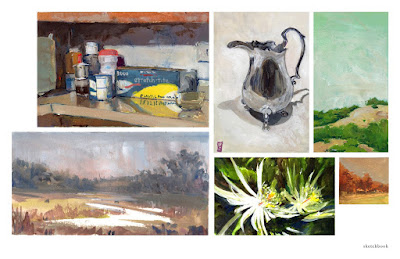Hi everyone, this is Quan
To start about Lighting and Gradation on surface, here are the fixed setting of what I'm going to use:
1/ White single lama... oops, light source.
2/ White cube close to white corner of a white room.
I. YOUR EYESIGHT's LIGHT SENSITIVITY ( sound dangerous and serious!!!)
the setting is LIGHT SOURCE casts shadow everywhere EVENLY !!!
1/ The top illustration indicates light hitting the surface of anything in microscopic scale. We can see that though the surface feel smooth to us, it does still have some texture. Therefore, the light source still casts the shadow on it. We just find it DIFFICULT to see. Keyword: Difficult.
2/ The bottom: Imagine there is a bunch of dudes in black suit getting in square formation. If you're Zeus looking down on them from the top of Olympus, you will look at them like the left bottom corner. If you're human like me, you look at them like the right corner. SQUINT and you can see 2 different values. The closer to you,the lighter it is.
TO CONCLUDE: It's DIFFICULT TO SEE, but it's still there. Let think of those shadows from the top image as those black suit dudes. The further the area from you, the more of those shadows you will see in a same area, therefore it will be be darker. IT GRADATES FROM LIGHT TO DARK from your eyes.
II. LIGHT SOURCE AND DISTANCE
RED BOX : Which distance from the top black dot to is shorter? Point A or B? OF COURSE YOU KNOW IT.
ok, let's move on to the main images
3/ As you can see, when light source casts on objects with same height, the further the objects is, the longer the shadow is . Applying this onto the surface mentioned in 1/ and 2/, you know that the further the area from the light sources, the darker it will be.
4/ Just to illustrate how light radiates to 3 walls (equal distance to the light source) in the room. The bigger ring, the darker it will be.
III. PING-PONG LIGHT ( or Reflecting light)
Light is just a wave of photon. And photon behaves like ping pong ball. IT BOUNCES.
5/ The top image illustrates how the light ( or just a photon particle) works. It goes and hits the ground, then BOUNCES, hitting the wall, BOUNCES off the wall, and keep moving like that until the darkness swallows it.
6/ Imagine there are two guys practice soft-hardcore-ball: the pitcher and me. The pitcher is professional, therefore he hits the ground same spot over and over. I'm dumb.
In the first case, the ball hit my belly, which hurts the shit out of me.
In the second case, I'm getting smarter, and I come close. The ball hits my nut and almost kills me.
As you can see, the ball carries forces in it. So does the photon. Photon carry light power in it. The further the ball travel, the less powerful it is. This also apply to the photon, which is light.
IV. LOGIC IN THINKING.
This is up to you. But the gradation of the surface works based on what I mention above. Now is when you combine them all together.
The cube here is sample: Cube here has no wall, no corner so the reflection light is only come from the floor.
All the arrows go from light to dark. The blue arrows indicate how light gradates from you eye. The red arrows indicate how light gradate from your light source. Here I just indicate how value of surface will gradate, NOT HOW MUCH it will gradate nor how DARK the value is.
Now it's your turn to put that cube into a wall and close to the corner. Start thinking good luck.



















